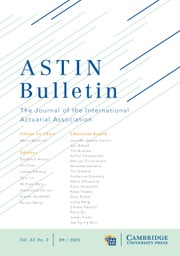No CrossRef data available.
Article contents
Optimal surrender policy for reverse mortgage loans
Published online by Cambridge University Press: 24 September 2024
Abstract
This study conducts an optimal surrender analysis of reverse mortgage (RM) loans offered to elderly homeowners as a financing option. Recent market evidence on borrower early surrenders has raised concerns about the marketability of RM products and their impact on the program viability. In this article, we derive the borrower optimal surrender strategy as a function of the underlying value of the home used as collateral for RM contracts with tenure payment option. Using a probabilistic approach to American option pricing, we present a decomposition result for the value of the contract as the sum of its European counterpart without the surrendering provision and an early exercise premium. The methodology allows policymakers to assess the financial incentive of their policy design, from which we explain the existing market evidence about borrower rational lapse by means of the resulting surrender boundary and reference probabilities.
- Type
- Research Article
- Information
- Copyright
- © The Author(s), 2024. Published by Cambridge University Press on behalf of The International Actuarial Association


